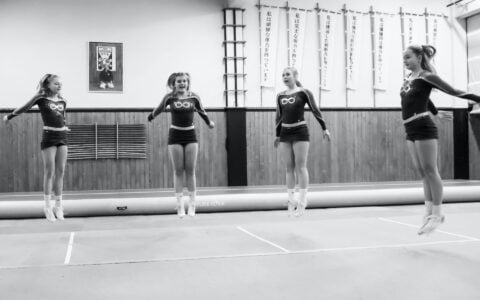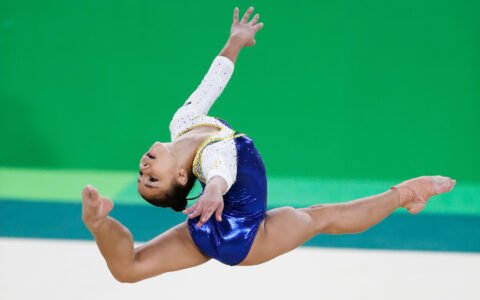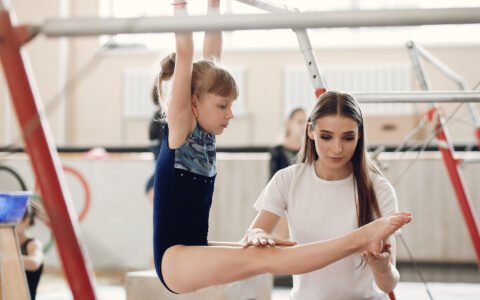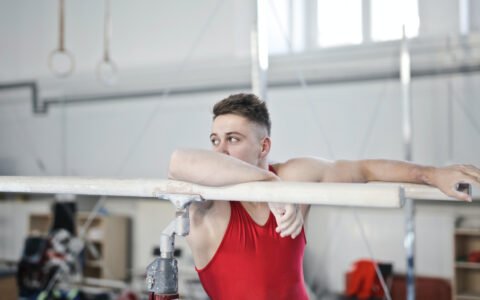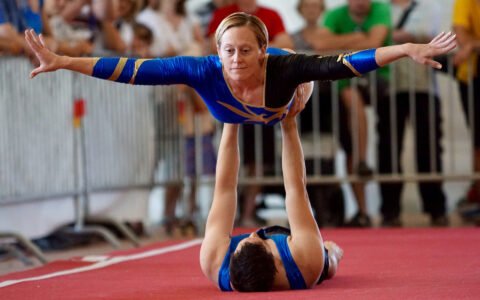Preschool gymnastics is the starting point for your little one to learn all the fundamentals and basics of this amazing sport! Beginning to experience independence and basic skills, your gymnast with improve coordination, strength and so much more.
Why is Gymnastics Good for Preschooler’s Development?
Gymnastics isn’t just to learn cool new moves, the sport brings your child new obstacles and challenges which they may not be able to experience in their home setting.
Balance and Coordination
Unlike other children’s sports, gymnastics includes a lot of equipment and apparatus that really play a part in improving balance and coordination.
From swinging on bars to walking along the beam, gymnastics is teaching children to use their core strength for stability without them even realising.
Both balance and hand-eye coordination are key in gymnastics to keep the athlete safe to perform the skills required. Because of this, gymnasts are taught the basics of balance from the get-go. Simple skills such as throwing and catching are often taught in preschool-aged gymnastics, this assists with their starter coordination and reactions.
When it comes to children learning, it’s good for them to be opened up to a little bit of risk but also very important to keep them safe. In beginner gymnastics one of the fundamentals is teaching children to ‘fall correctly’, learning to push away from the beam and jump off if about to fall.
Strength and flexibility
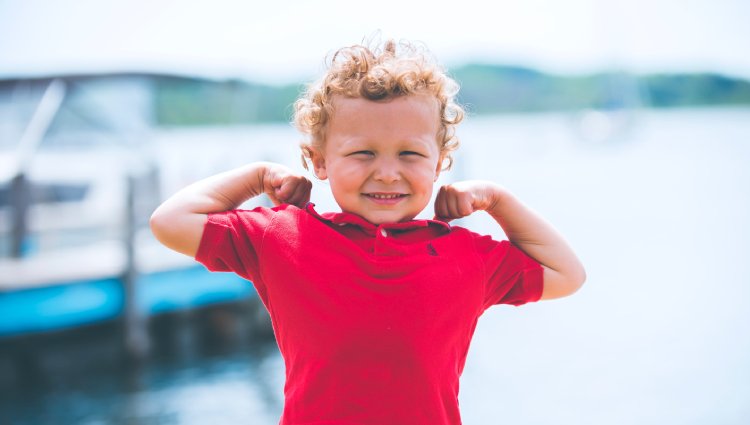
Preschool gymnastics settings often have a lot of equipment and props out for the children. Just taking part in the sport itself will improve your little one’s strength, but the equipment and specific exercises really enhance this!
Gymnastics is a sport that is known for flexibility, so where your child may not learn to do the full splits in this lesson, their muscles will begin to become more supple, making certain obstacles they may have struggled with before, easier.
Strength and flexibility play a huge part in children’s development, and experiencing new ways of using their strength in a gymnastics class really does encourage a full-body exercise, which therefore minimizes injury in the outdoor world!
Why is Gymnastics So Important for Children?
Fun Factor
Preschool gymnastics is learned a lot through imagination and themes, so whilst the child is taking part in the sport and learning, they are also having fun doing it.
Clubs introduce themes such as ‘under the sea’ where the coaches may encourage the gymnasts to imagine they are tiptoeing over a plank in the water using extra props to enhance their imagination.
Preschool gymnastics also includes a lot of learning through games, whether it’s individual or team building games, the little ones begin to learn instructions and rules and learn that it’s ok to lose sometimes!
Learning Independence
Though children will usually work with a group in their gymnastics lessons, the sport itself teaches many independent aspects as it is a solo sport.
Gymnastics teaches the basics of independence, from walking along the beam alone to completing their first forward roll unaided. The sport teaches the importance of independence and helps build courage in young children when they master certain skills by themself.
Moving up to preschool gymnastics from a ‘mummy and me’ class can be a big jump for little ones, especially as they may not be used to experiencing new situations without their parent or guardian to go around with them.
Being in a class by themselves may be daunting at first, but when the child begins to start learning new skills and gaining achievements to show after class, it really does give them that independent confidence!
Learning to Follow Instructions
When it comes to gymnastics, safety is paramount. Coaches teach gymnasts the importance of being safe with appropriate rules set in place, these teach the young children to follow instruction and learn why we must follow the rules.
Gymnastics is taught a lot through physical and verbal instruction, but a big section of preschool gymnastics is learned through visual teaching. Through many physical demonstrations, the preschool children watch their coach before completing the action or skill themselves, teaching them patience as well as visual learning.
Often in sports such as gymnastics, it is likely that at points the child will be asked to wait for their turn, or share a piece of apparatus with another child. This acts as an excellent way to encourage children to work with others but also to be understanding and accommodating when it is the other child’s turn.
Socialising with others
Any sport is a great way to get your child to socialise with other children outside of their usual childcare or school setting. Although competitive gymnastics is a solo sport, team building and socialisation in training are always encouraged.
A preschool gymnastics class consists of usually around 12 to 18 children, they may do some activities in a big group but will often be split into smaller groups of about four for the duration of the session.
Being in a group gives the young children the opportunity to socialise with other children their age but out of a school setting, working together to overcome obstacles and learning to cheer on your teammates and praise them for their achievements!
Not only is gymnastics great for making friends, but it’s also a great way to introduce to children that others may learn skills before them, and may beat them in certain games. It’s about learning that it’s ok not to always win, and it is all about the fun factor and congratulating those who succeed, even if it is sometimes not themselves.
Self-confidence
There is nothing better than seeing the face of your little one when they have accomplished something new. Gymnastics comes with many mini-challenges, and especially starting from a young age children will experience new obstacles they may not have faced before.
Preschool gymnastics is about learning the very basics and fundamentals of the sport, keeping it fun and vibrant for the children. As they begin to learn new skills, or gradually improve with confidence such as making their way up to the bigger beam, a burst of self-esteem and confidence will begin to show!
What do 4 year olds Learn at Gymnastics?
Moving up to a preschool gymnastics class from baby gymnastics, the sessions are a lot more structured as more often than not, at this stage the children come into class independently without their parent/guardian.
At age 3 and 4, and sometimes even as young as 2. Children will be in a preschool class following the instructions of their coach.
Preschool gymnastics is about learning the basics skills of gymnastics, in these sessions your child will likely learn the basics of each piece of apparatus. Session plans may vary due to the ability of the children, coaches will often create side stations that will work the children’s skill, strength, and flexibility whilst they are physically helping one child.
Skills such as forward rolls, bunny hops, swinging, and straddle hangs are some examples of basic skills that will often be taught in preschool gymnastics. Of course, if your child is progressing further they will begin to move them on to more challenging skills such as cartwheels and circle ups.
What Should Preschoolers Wear To Gymnastics?
For a preschool gymnastics session, it is important that your little one is dressed in the appropriate clothing, the last thing you want is them being restricted which could affect their gymnastics and possibly cause injury.
Clothing
Most gymnastics clubs will have a written policy for what to wear to lessons. If they do not I would recommend anything that is flexible enough for your child to move around in, and something that won’t make them too hot.
A t-shirt and shorts or leggings are suitable for gymnastics as they are lightweight, allowing the child to move freely and also not too thick or long so your child will get hot.
Leotards are highly recommended for gymnastics, but very rarely compulsory at this age. Your club will often sell their own style leotard, but they can easily be found online with a large range of designs and styles!
Hair
If your child has long hair it is important that you have it tied back for their gymnastics class. As mentioned previously moving up to preschool gymnastics the children will start to learn a lot of new skills, which can become dangerous if long hair is not tied back as it has the risk of getting caught in equipment.
Headbands are also not recommended for gymnastics, though they are excellent at getting hair out of the face they can really dig into the head if a child was to lean on it when doing a skill such as a forward roll. With that being said, elastic material headbands are great!
Jewellery
Different clubs have different jewellery rules, but my overall blanket recommendation would be to take it all off! Though many clubs allow small stud earrings, I would definitely suggest taking them out before gymnastics if you can, to avoid them digging in or getting caught.
If jewellery can not be taken off for any reason it should be covered up. For example, small earrings should be taped up with some micropore tape.
If your little one has religious jewellery they can not remove, clubs will respect this but highly recommend tight clothing over it or a sweatband to avoid it catching on anything.
Final Thoughts- Should my Preschooler Do Gymnastics?
In conclusion, yes I would recommend that all parents introduce their little one to gymnastics! You never know how much you may love something until you try, and gymnastics is such an all-around beneficial sport that it would be a great extracurricular activity to any child.

